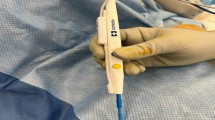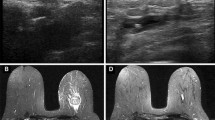Abstract
This chapter discusses technical aspects of wire-localized and seed-localized lumpectomy, including instrumentation and equipment, patient positioning, incision, dissection technique, irrigation, hemostasis, and closure techniques for wire- and seed-localized lumpectomy. The authors also offer pearls and pitfalls.
Access provided by Autonomous University of Puebla. Download chapter PDF
Similar content being viewed by others
Keywords
Preference Card
-
Drapes: minor laparotomy sheet, ¾ sheets × 3
-
Sutures: 3-0 Vicryl, 4-0 Monocryl
-
Medications: 1% and 0.5% Marcaine in a 50/50 mixture
-
Equipment: mastectomy set, #15 blade scalpel, Neoprobe and cover, electrocautery (set 40/40) and pad, liga clip, Yankauer suction and suction tubing, 0.25 inch Steri-Strips, surgical glue, Kerlix, and surgical bra
Patient Positioning/Operating Room Setup (See Fig. 5.1)
-
Patient is supine with the arm abducted 90 degrees.
-
All pressure points are padded, pillow under knees.
-
Surgeon stands ipsilateral to dissection site – below arm.
-
Surgical assistant stands ipsilateral to dissection site – above arm.
Nodal Points
Wire Localized
Incision (Fig. 6.1)
-
Incision should be small and within 3 cm of the mass.
-
Optimal cosmesis is the goal when planning your incision.
-
Options include curvilinear, circumareolar, or inframammary incisions.
-
Radial incisions may be used in the lower pole of the breast but should be avoided in the upper pole due to skin contracture resulting in distortion of the breast and nipple-areolar complex.
-
Infiltrate this skin with local anesthesia (1% and 0.5% Marcaine in a 50/50 mixture).
-
Skin incision is made with 15 blade scalpel, sharp dissection to breast tissue.
Dissection
-
Electrocautery is then used to dissect through the subcutaneous tissue.
-
Skin flaps are raised using 15 blade scalpel.
-
Allis forceps may be used to grasp the glandular tissue surrounding the lesion and provide traction.
-
The dissection continues with complete excision of the lesion.
-
The specimen is oriented and tagged for pathologic examination. Excision of the radiologic clip is confirmed with intraoperative examination.
Irrigation, Hemostasis, and Closure
-
The cavity is then irrigated, and proper hemostasis is obtained with electrocautery and direct pressure.
-
Approximate the deep dermal layer with simple inverted interrupted stitches using 3-0 Vicryl.
-
The dermis is then closed with a 4-0 Monocryl running subcuticular stitch.
-
0.25 inch Steri-Strips are placed along length of incision.
-
Kerlix fluff placed and surgical bra applied to patient.
Seed Localized
-
Preoperatively (2 weeks up to day of surgery), a radionuclide seed is placed in radiology.
Incision (Fig. 6.2)
-
Once patient is prepped and draped, the Neoprobe is placed over the breast to confirm location of the seed.
-
A marking pen is used to mark the site of incision.
-
Infiltrate this skin with local anesthesia (1% and 0.5% Marcaine in a 50/50 mixture).
-
Skin incision is made with 15 blade scalpel, sharp dissection to breast tissue.
Dissection
-
Electrocautery is then used to dissect through the subcutaneous tissue.
-
Skin flaps are raised using 15 blade scalpel.
-
Allis forceps may be used to grasp the glandular tissue surrounding the seed.
-
The dissection continues with complete excision of the lesion.
-
Neoprobe may be used during to dissection to guide and orient.
-
Explanation of the seed in the specimen is confirmed “hot” with Neoprobe and count of 0 in the breast cavity. The tissue is oriented and tagged for pathologic examination. The excision of the radiologic clip and seed is confirmed to be within the specimen with intraoperative radiologic examination.
Irrigation, Hemostasis, and Closure
-
The cavity is then irrigated, and proper hemostasis is obtained with electrocautery cautery and direct pressure.
-
Approximate the deep dermal layer with simple inverted interrupted stitches using 3-0 Vicryl.
-
The dermis is then closed with a 4-0 Monocryl running subcuticular stitch.
-
0.25 inch Steri-Strips are placed along the length of incision (parallel) or may use surgical glue and then place Steri-Strips in the same fashion.
-
Kerlix fluff placed and surgical bra applied to patient.
Pearls and Pitfalls
Common complications include surgical site infection, seroma, and hematoma. Pitfalls of lumpectomy include the possibility of positive margins, requiring re-excision. Pearls include reviewing preoperative imaging.
Author information
Authors and Affiliations
Corresponding author
Editor information
Editors and Affiliations
Access Reader Checklist Appendix
Access Reader Checklist Appendix

Rights and permissions
Copyright information
© 2020 Springer Nature Switzerland AG
About this chapter
Cite this chapter
Rajan, M., Moon, S., Blake, C. (2020). Lumpectomy (Wire Localized and Seed Localized). In: Rosenthal, R., Rosales, A., Lo Menzo, E., Dip, F. (eds) Mental Conditioning to Perform Common Operations in General Surgery Training. Springer, Cham. https://doi.org/10.1007/978-3-319-91164-9_6
Download citation
DOI: https://doi.org/10.1007/978-3-319-91164-9_6
Published:
Publisher Name: Springer, Cham
Print ISBN: 978-3-319-91163-2
Online ISBN: 978-3-319-91164-9
eBook Packages: MedicineMedicine (R0)






